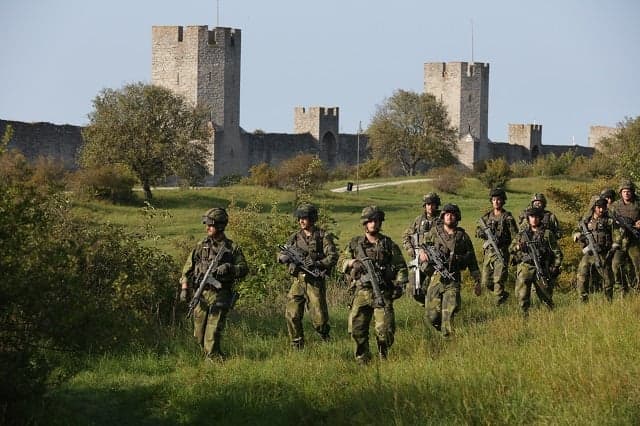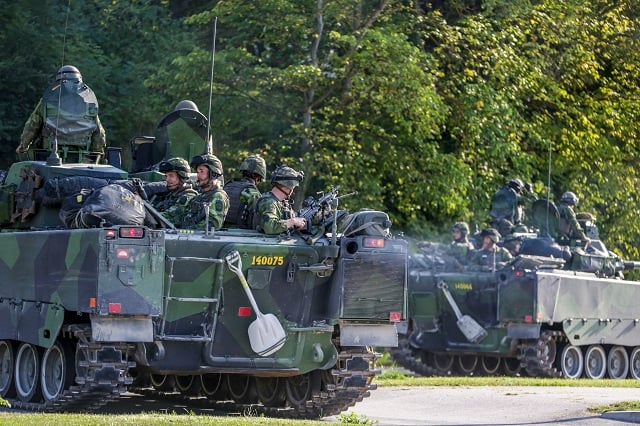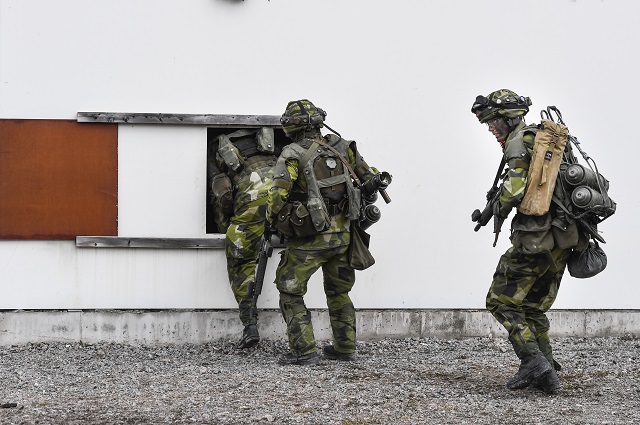Inside Sweden's re-established military unit on Gotland

Under an icy rain, camouflage-clad Swedish soldiers crouched behind a log pile, aimed their machine guns towards the Baltic Sea and, at their officers' barked orders, opened fire down the snow-covered range.
A few kilometres away another group wrapped in thick winter jackets, body armour and helmets fired anti-tank missiles, throwing up sprays of ice and snow behind them as instructors watched the orange rockets streak down the range. It was routine training for the young recruits based on the Baltic island of Gotland, but these troops are at the forefront of Sweden's efforts to bolster its military as Stockholm worries about Russian intentions in Europe and the Baltic.
Following the annexation of Crimea, the conflict in Ukraine, incidents of Russian military jets approaching Swedish aircraft around the Baltic and the 2014 sighting of a mystery sub – suspected to be Russian, which Moscow denied – near Stockholm, Sweden has scrambled to beef up a military that was cut back after the end of the Cold War. The Nordic nation, which has not been to war in two centuries, reintroduced limited conscription in 2017, stepped up defence spending and placed a garrison on Gotland in January 2018.
READ ALSO:
-
'Sweden would not be able to defend Gotland'
-
Did Russian 'threat' lead to Swedish troops on Gotland?
-
Sweden rebuilds Cold War missile system from museums
Taking a break from the target practice by a campfire on the icy ground near the firing ranges, Ida Delin, a young lance-corporal from Gothenburg who is a part of the new garrison, was upbeat about her posting to the island.
"Everybody feels it's very important, what we're doing really matters for Sweden," she said, the collar of her camouflage smock pulled up around her ears to protect against the cold.

File photo: Sören Andersson / TT
Rebuilding the garrison
Gotland's location in the Baltic means it has a high strategic value, giving its owner the ability to dominate nearby air and seaways, Defence Minister Peter Hultqvist said. But regional developments, from Russia's 2008 conflict with Georgia to the 2014 annexation of Crimea and the conflict in eastern Ukraine, prompted a rethink in Sweden.
"I don't talk about the threat directly to Sweden, I talk about a security situation that is worse today than ten years ago," Hultqvist told AFP. "Because of that we have upgraded our national military capability."
Russian Foreign Minister Sergei Lavrov has long denounced the "myth of a Russian threat" in Europe and accused Western powers of destabilizing the continent.
Down the road from the firing ranges, the regiment paraded under a leaden sky to mark the anniversary of the creation of the first unit on the island in 1811, presided over by the unit's mascot – a ram named Harald V– and its commander, Colonel Mattias Ardin, a powerfully built native of the island tasked with rebuilding the garrison.
READ ALSO:
-
Twice as many people to undergo military service tests in Sweden this year
-
Sweden to train 'cyber soldiers' during military service
-
Sweden mobilises Home Guard for first time since 1975
The 50-year-old started his military career at the garrison in the twilight years of the Cold War, when non-aligned Sweden eyed the USSR warily – its navy chased suspected Soviet submarines from its waters and it maintained a conscript army to watch its borders.
Following the fall of the Soviet Union, Sweden cut defence spending, doing away with its regiment on Gotland in 2005 and selling its barracks. But with the conflict in Ukraine and rising tensions between Moscow and the European Union, Sweden's parliament voted to return troops to the island again in 2016.
"We have a strong Russia that has a lot more military activity than before and we see what is happening in Ukraine, so we see a deteriorating security situation," Ardin said after the ceremony.
Nearby, bulldozers and diggers worked on new facilities for the 282 full-time soldiers that make up the garrison and that will shelter the several dozen tanks and armoured vehicles based there.

File photo: Pontus Lundahl/TT
'Everyone will be affected'
Sweden's decision to boost its presence in the Baltic can also be seen as a message to its neighbours.
NATO has deployed troops to the Baltic states and Poland as part of its response to Russia's involvement in Ukraine and although Sweden is not a member of the alliance it has increased cooperation with it, dispatching troops to take part in military exercises in Norway last November.
"The official view is also that if any war does take place in the Baltic region, then we will all be affected," said Robert Dalsjo of the Swedish Defence Research Agency.
The tall stone walls around the island's medieval capital Visby testify to Gotland's turbulent history – it was fought over by Swedes, Danes, Germans and Teutonic Knights and it was even briefly occupied by Russia during the Napoleonic wars.
News of the army's return prompted some objections from the community, but other residents were more sanguine about the changes. Outside his office on a street leading up to the Old City walls, Niclas Bylund, a project manager, saw unexpected positives for the island.
"We have people moving here with their families, more people to spend money in the shops," he shrugged. "A more lively island in the low season," he smiled.
By Tom Little/AFP
READ ALSO:
Comments
See Also
A few kilometres away another group wrapped in thick winter jackets, body armour and helmets fired anti-tank missiles, throwing up sprays of ice and snow behind them as instructors watched the orange rockets streak down the range. It was routine training for the young recruits based on the Baltic island of Gotland, but these troops are at the forefront of Sweden's efforts to bolster its military as Stockholm worries about Russian intentions in Europe and the Baltic.
Following the annexation of Crimea, the conflict in Ukraine, incidents of Russian military jets approaching Swedish aircraft around the Baltic and the 2014 sighting of a mystery sub – suspected to be Russian, which Moscow denied – near Stockholm, Sweden has scrambled to beef up a military that was cut back after the end of the Cold War. The Nordic nation, which has not been to war in two centuries, reintroduced limited conscription in 2017, stepped up defence spending and placed a garrison on Gotland in January 2018.
READ ALSO:
- 'Sweden would not be able to defend Gotland'
- Did Russian 'threat' lead to Swedish troops on Gotland?
- Sweden rebuilds Cold War missile system from museums
Taking a break from the target practice by a campfire on the icy ground near the firing ranges, Ida Delin, a young lance-corporal from Gothenburg who is a part of the new garrison, was upbeat about her posting to the island.
"Everybody feels it's very important, what we're doing really matters for Sweden," she said, the collar of her camouflage smock pulled up around her ears to protect against the cold.

File photo: Sören Andersson / TT
Rebuilding the garrison
Gotland's location in the Baltic means it has a high strategic value, giving its owner the ability to dominate nearby air and seaways, Defence Minister Peter Hultqvist said. But regional developments, from Russia's 2008 conflict with Georgia to the 2014 annexation of Crimea and the conflict in eastern Ukraine, prompted a rethink in Sweden.
"I don't talk about the threat directly to Sweden, I talk about a security situation that is worse today than ten years ago," Hultqvist told AFP. "Because of that we have upgraded our national military capability."
Russian Foreign Minister Sergei Lavrov has long denounced the "myth of a Russian threat" in Europe and accused Western powers of destabilizing the continent.
Down the road from the firing ranges, the regiment paraded under a leaden sky to mark the anniversary of the creation of the first unit on the island in 1811, presided over by the unit's mascot – a ram named Harald V– and its commander, Colonel Mattias Ardin, a powerfully built native of the island tasked with rebuilding the garrison.
READ ALSO:
- Twice as many people to undergo military service tests in Sweden this year
- Sweden to train 'cyber soldiers' during military service
- Sweden mobilises Home Guard for first time since 1975
The 50-year-old started his military career at the garrison in the twilight years of the Cold War, when non-aligned Sweden eyed the USSR warily – its navy chased suspected Soviet submarines from its waters and it maintained a conscript army to watch its borders.
Following the fall of the Soviet Union, Sweden cut defence spending, doing away with its regiment on Gotland in 2005 and selling its barracks. But with the conflict in Ukraine and rising tensions between Moscow and the European Union, Sweden's parliament voted to return troops to the island again in 2016.
"We have a strong Russia that has a lot more military activity than before and we see what is happening in Ukraine, so we see a deteriorating security situation," Ardin said after the ceremony.
Nearby, bulldozers and diggers worked on new facilities for the 282 full-time soldiers that make up the garrison and that will shelter the several dozen tanks and armoured vehicles based there.

File photo: Pontus Lundahl/TT
'Everyone will be affected'
Sweden's decision to boost its presence in the Baltic can also be seen as a message to its neighbours.
NATO has deployed troops to the Baltic states and Poland as part of its response to Russia's involvement in Ukraine and although Sweden is not a member of the alliance it has increased cooperation with it, dispatching troops to take part in military exercises in Norway last November.
"The official view is also that if any war does take place in the Baltic region, then we will all be affected," said Robert Dalsjo of the Swedish Defence Research Agency.
The tall stone walls around the island's medieval capital Visby testify to Gotland's turbulent history – it was fought over by Swedes, Danes, Germans and Teutonic Knights and it was even briefly occupied by Russia during the Napoleonic wars.
News of the army's return prompted some objections from the community, but other residents were more sanguine about the changes. Outside his office on a street leading up to the Old City walls, Niclas Bylund, a project manager, saw unexpected positives for the island.
"We have people moving here with their families, more people to spend money in the shops," he shrugged. "A more lively island in the low season," he smiled.
By Tom Little/AFP
READ ALSO:
Join the conversation in our comments section below. Share your own views and experience and if you have a question or suggestion for our journalists then email us at [email protected].
Please keep comments civil, constructive and on topic – and make sure to read our terms of use before getting involved.
Please log in here to leave a comment.